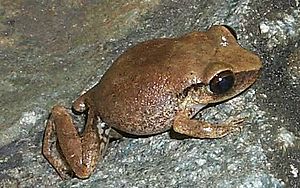Red-eyed coqui facts for kids
Quick facts for kids Red-eyed coqui |
|
|---|---|
 |
|
| Conservation status | |
| Scientific classification |
The red-eyed coqui is a small frog also known as the churi, coqui churi, or coqui de las Antillas. Its scientific name is Eleutherodactylus antillensis. You can find this frog in Puerto Rico, the British and U.S. Virgin Islands. It was also brought to Panama.
There are many similar frogs in these tropical places. But the red-eyed coqui stands out because of how it looks, where it lives, and what it does. It belongs to a group of frogs called Eleutherodactylus. This group has about 185 different kinds of frogs. They live in the southern United States, Central America, South America, and the Caribbean. Puerto Rico alone has 16 types of these frogs.
The red-eyed coqui arrived in Panama City in the late 1960s. It first settled in city parks. Then, in the 1980s, it started to spread outside the city. In Puerto Rico, where it is most common, it lives up to 1,200 meters (about 3,900 feet) above sea level. Many people confuse it with the common coqui, which is a symbol of Puerto Rico. However, these two frogs are quite different when you look closely.
Contents
Physical Characteristics
The red-eyed coqui has a special look. It has a broad, flat head with sharp angles. Its body is short. Its eyes are a cinnamon red color. You might also see black spots on its thighs. There's a black stripe on each side of its nose. A short black line sits above its ear drum. A light line runs down the middle of its back.
Its upper body is usually a pale gray or dull brown. This frog has toes that are not webbed. Its fingers and toes are long. People often mix up the red-eyed coqui with the common coqui. This is because they seem to live in similar places.
Habitat
The red-eyed coqui lives in forests that are not too high up. These can be dry forests. It is very common in open areas that have been changed by people. Unlike the common coqui, the red-eyed coqui prefers dry places. It can go a long time without rain. It just needs to stay hidden to keep from drying out.
In Panama, you can find these frogs in cities. They live in gardens and empty lots. Even though they are spread out, they are not as many as other Eleutherodactylus frogs. During the day, they hide under grass roots, loose tree bark, rocks, logs, and even trash. At night, they move to low bushes and tree branches. This helps them hunt for food.
Behavior and Diet
Red-eyed coquis are active at night. They are predators, meaning they hunt other animals for food. They mostly eat insects, spiders, and other small creatures like snails. They hunt from when the sun sets until it rises.
Male red-eyed coquis make special calls. They make a "churee-churee" sound without stopping. They also have a "kee-kee-kee" call. This call might be to protect their territory. After midnight, their calls become much quieter. To find a mate, male coquis call from high places. They keep calling until a female frog finds them.
Reproduction and Life Cycle
The way red-eyed coquis reproduce is unique. Frogs in the Eleutherodactylus group do not need water for their babies to grow. This is because they do not have a tadpole stage. Instead, the female frog lays her eggs on land. She lays about 24 to 42 eggs. She hides them under a thin layer of damp leaves or soil.
When the eggs hatch, tiny frogs come out. They look just like miniature adult frogs. They do not go through a tadpole stage like many other frogs. Sometimes, the adult frogs will guard their babies as they grow.
Survival and Threats
The red-eyed coqui is listed as a species of 'Least Concern' on the IUCN Red List. This means it is not in danger of disappearing. One reason for this is that it can live in many different types of places. In Puerto Rico, the forests are growing. This helps create more good homes for the frogs.
It is not fully clear what specific things might threaten this frog. However, one of its main predators is the Cuban tree frog (Osteopilus septentrionalis). This predator helps to control the number of red-eyed coquis.
See also
 In Spanish: Coquí churí para niños
In Spanish: Coquí churí para niños


